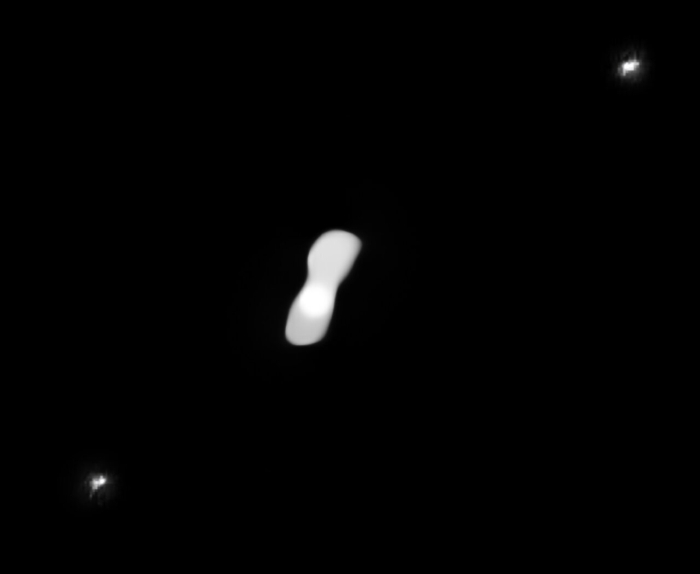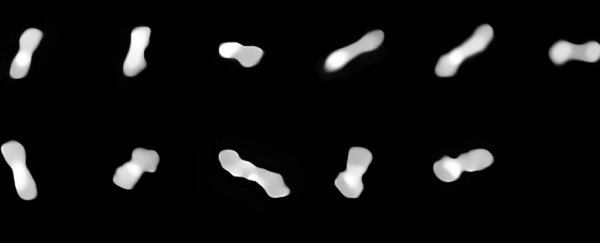Not all asteroids are built alike. Some, however, are so far from alike that they have officially crossed the line into wonderfully weird.
Such is the case for an asteroid named Kleopatra, otherwise hanging out quite normally in the Asteroid Belt between Mars and Jupiter. It consists of two lobes, connected by a long neck – a morphology that has earned it the nickname "dog bone asteroid".
This unusual-looking space rock even has two small moons of its own – AlexHelios and CleoSelene, named after the children of ancient Egypt's famous Pharaoh, Cleopatra.
We've known about this incredible space oddity for about two decades, but scientists have now obtained the most detailed images of it we've seen yet. This is helping us figure out how Kleopatra formed, and the results suggest that the moons were born from Kleopatra's own material.
"Kleopatra is truly a unique body in our Solar System," said astronomer Franck Marchis of the SETI Institute and the Laboratoire d'Astrophysique de Marseille in France.
"Science makes a lot of progress thanks to the study of weird outliers. I think Kleopatra is one of those and understanding this complex, multiple asteroid system can help us learn more about our Solar System."
In two studies published in Astronomy & Astrophysics, astronomers used new images of Kleopatra to obtain a more accurate set of measurement constraints for the asteroid, developing a new 3D model, and more accurately defining the orbits of AlexHelios and CleoSelene.
The work was conducted using observations obtained with the powerful SPHERE instrument attached to the European Southern Observatory's Very Large Telescope in Chile. As Kleopatra tumbled through space, the researchers were able to obtain images from different angles.
From this, they were able to determine that Kleopatra is roughly 270 kilometers (168 miles) long, with one of its dumbbell lobes larger than the other, and that the two are joined by a relatively thick neck. The newly described dimensions then allowed the researchers to calculate Kleopatra's volume.
 (ESO/Vernazza, Marchis et al./MISTRAL algorithm [ONERA/CNRS])
(ESO/Vernazza, Marchis et al./MISTRAL algorithm [ONERA/CNRS])
Above: Kleopatra with AlexHelios and CleoSelene.
A second team, meanwhile, was working to constrain the orbits of AlexHelios and CleoSelene. This is important, because orbits are constrained by the gravitational field they move through, which in turn correlates to the masses in the system.
"This had to be resolved, because if the moons' orbits were wrong, everything was wrong, including the mass of Kleopatra," explained astronomer Miroslav Brož of Charles University in Czechia.
Using the new observations combined with mathematical modelling, the team was able to describe the moons' orbits with a greater-than-ever degree of accuracy. This allowed for a new calculation of Kleopatra's mass: 2.97 x 1018 kilograms, significantly lower than previous calculations, which yielded 4.64 x 1018 kilograms.
Once you have the mass and the volume of an object, you can calculate its density. Using the results of Brož and his team, Marchis and his colleagues then recalculated the density of Cleopatra. Assuming that Kleopatra is metal-rich, the asteroid's density turned out to be very low.
This can tell us something about how Kleopatra formed. Low density suggests that the asteroid is rather porous – a loose "rubble pile" of bits of rock barely hanging together. Such rubble piles are thought to have formed when material is flung out from a parent body during a giant impact, gradually reassembling over time.
If it is porous, Kleopatra is barely holding itself together. The asteroid has a faster-than-average rotation period of around 5.4 hours. That period is just on this side of stability; were it to speed up, the centripetal force would tear it apart.
This state of critical rotation means that effective gravity at the equator is low, and material in this region could be lifting away from the asteroid.
If this is true, it gives us a clue about the formation of AlexHelios and CleoSelene. If material is being ejected from Kleopatra, it could have coalesced in orbit, forming the moons – making them, indeed, the asteroid's children.
The two papers have been published in Astronomy & Astrophysics. They can be found here and here.
